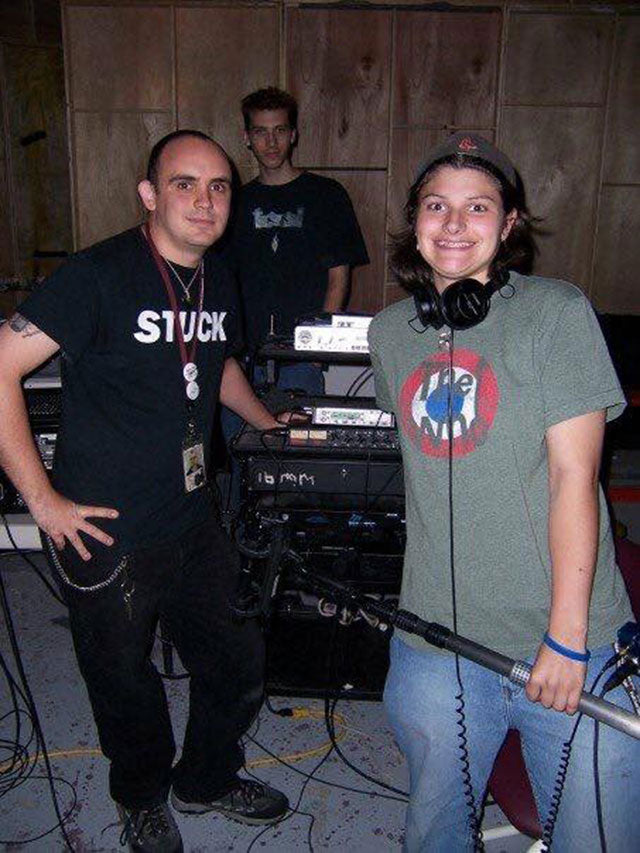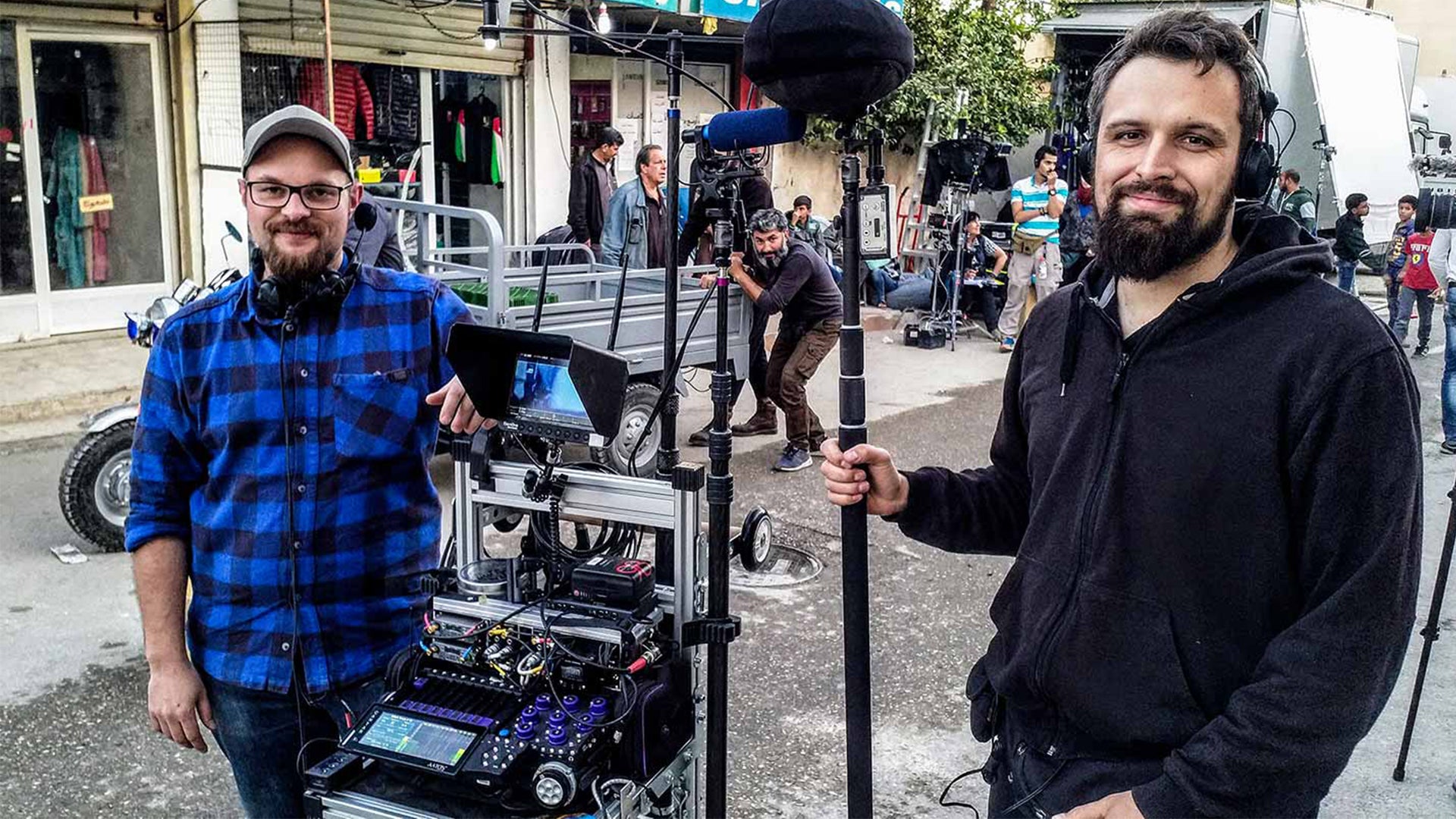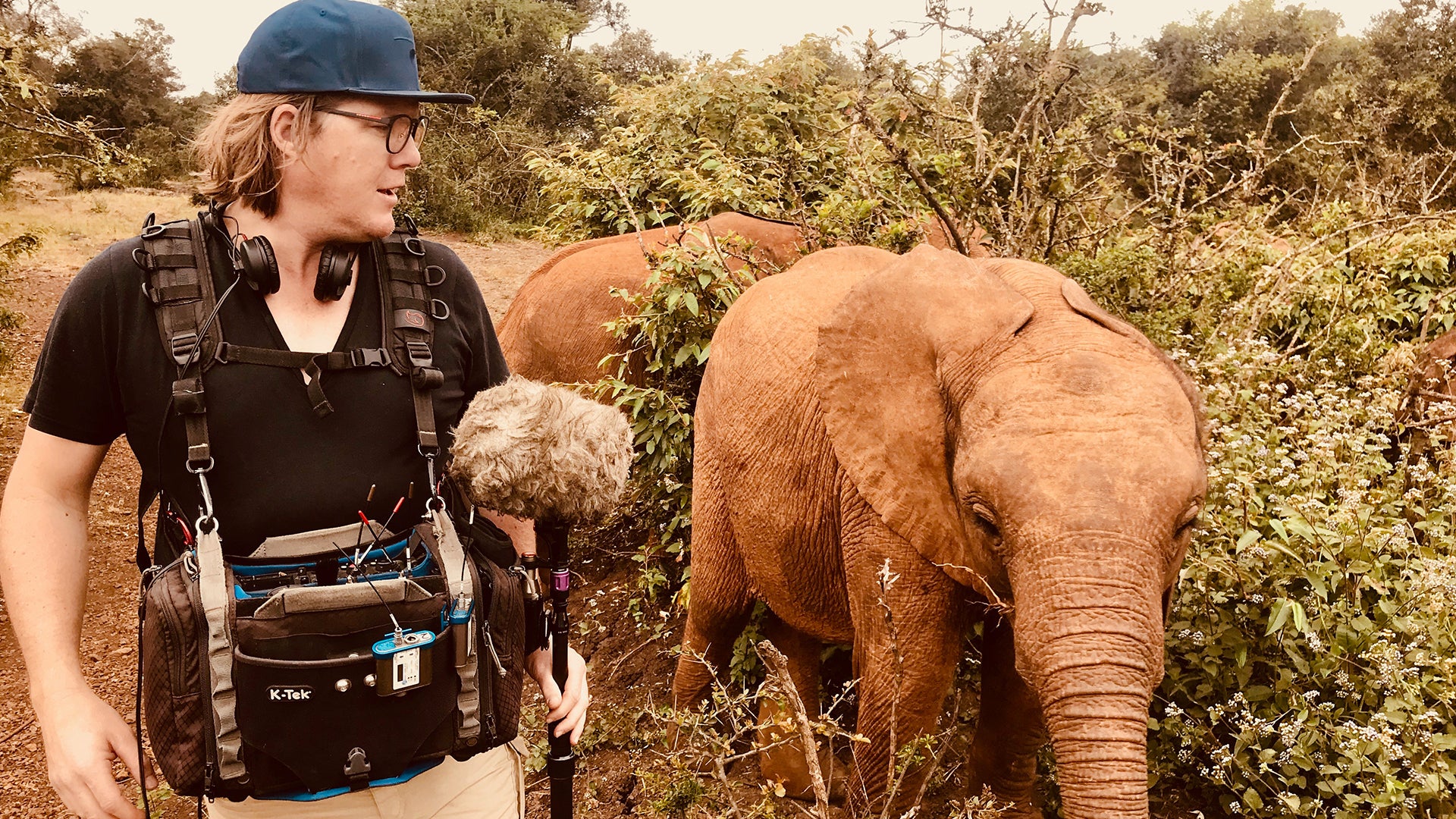
Mixer Raam Brousard and Michaela between takes on Darlin’.
Michaela Girouard is a versatile and highly-experienced freelance boom operator/utility sound technician, currently based in New Orleans, Louisiana. She’s worked on a range of productions including Preacher, Darlin’, Take Your Pills, Synchronic and Hot Date, all of which have brought unique sets of audio challenges to the table.
We took a few moments at Bubblebee to chat with her about early interests, what it’s like to work in New Orleans [hint: it’s great!], production craft, and equipment choices for those difficult working days. You can find out more about Michaela’s work here.
How did you become interested in sound?
Microphones have fascinated me since I was a little kid. My mom was an audiologist, so listening was always a big part of my childhood.
When I was a freshman in high school, I learned how to run my theater’s sound board. People would rent out the theater for events, and we would get to do all the paid tech jobs. In my mid-teens, I was making fifteen dollars an hour running a sound board, even though I was too young to get a job bagging groceries!
After high school, I went to college at Full Sail University in Orlando, Florida. I studied Film there, and that’s when I really found my passion for location sound. At the age of nineteen, I was already a production mixer on my final project.

Michaela at Full Sail University, with audio teacher and mentor Mikey Jones.
Full Sail was originally launched as a recording arts school, so it’s great for kids who are interested in any aspect of sound production. I spent hours after classes in the sound room learning about every piece of equipment I could get my hands on. They really stay on top of new technology there, so I had access to the latest location audio gear.
New Orleans sounds like a great place to be based in! What’s it like working there?
I was born and raised on the East Coast, so it’s nice to be able to live close to my mom.
I tried Los Angeles after I graduated, but quickly learned it wasn’t for me at all. Then one of my best friends from college told me about an opportunity for work in New Orleans, so I decided to check it out.

From left to right: mixer Rob Smith, boom op Luke Kelly and Michaela on the set of Skinny Dip.
There’s a culture and spirit in New Orleans that’s unmatched, and it has a wonderful, small film community; you generally know most of your crew, even when you’re working jobs day-to-day. I’ve had the opportunity to work with some awesome, seasoned mixers and have learned so much from them.
It does get hot here in the summer, and the humidity is crazy. We use lots of Superstick and have to put transmitters in condoms on exterior days in the summer. When people come here from LA in the summer they always complain about the heat, but we locals are used to it.
And of course, we have Mardi Gras here. That really is something else!
Any other locations you’ve worked in?
My first job out of college was a horror movie called Growth. It was shot entirely on location in Martha’s Vineyard, MA, which is a gorgeous island and one of my favorite places. That was a fantastic first job. I also had the opportunity to work in Monument Valley, Utah, which is a beautiful place.
There’s definitely a magic working in New Orleans, though. I’ve never boomed abroad, so it would be great to have the chance to head somewhere farther afield.
Can you tell us about a particularly challenging production that you’ve worked on?
“The Spacer Kit on the 416 was a tremendous help, especially on one particular night when had to shoot on the roof of a bar.”
Every production comes with its own set of challenges.
Growth was shot in September and October 2008 in Massachusetts. We had water scenes, and it got cold there really fast. A good chunk of the shooting happened overnight, so temperatures were really low toward the end of production; despite this, everyone on the show was great and we faced the obstacles head-on.
That film was shot on the Red One at a time when Red cameras had just come out, so there were technical issues and we were constantly having replacement parts and accessories sent back and forth to the rental house in LA (Martha’s Vineyard is a small island with zero production resources). I think it was shortly after Growth when I decided I didn’t want to live in a cold climate!
I was first introduced to Bubblebee products towards the end of 2018 on a feature called Synchronic. We shot mostly on location, and we had to deal with inclement, windy weather. The Spacer Kit on the 416 was tremendous help, especially on one particular night when had to shoot on the roof of a bar.
We also had driving scenes inside a cloth-top Jeep, which are incredibly loud vehicles! The cloth top was constantly making noise, so I put a windscreen over a COS-11 and put a Windbubble over that, then mounted the whole thing to the visor. It made the dialogue come through clean, killed the outside noise, and softened the noise from the cloth top.
Any favorite productions? Go on, you can tell us!
Every production is different, but my favorites have been with easy-going sound departments.
In 2017, I boomed a horror feature called Darlin’ and my friend Raam Brousard mixed. We knew from the start what we were getting into, since it was a low-budget indie (around 600K). We worked crazy-long hours and faced multiple issues as a two-person team, but still had fun and remembered to laugh! At the end of the day, making a movie should be about having a bit of fun.

Booming on the set of Hot Date.
I recently wrapped the second season of the CollegeHumor series Hot Date. It’s an off-the-wall comedy show featuring a married couple who play multiple characters. I was booming on another two-person team with sound mixer Rob Smith, and we shot 10 episodes in 20 days! That really is a crazy accomplishment, doing an entire show as a two-person crew in such a short space of time. Rob is a mixer who is really easy-going, so when we were ‘in the weeds’ and facing tough moments, it was easy to get through everything because there was no added stress.
If you had to choose an absolute minimum of audio equipment to get you through your working day, what would it be? What would you pack?
For utility sound, there are a few things I always keep handy.
“I’d really love to see more women in this field. There are some badass sound women out there, but there’s always room for more!”
I always carry Transpore and 3M waterproof tape. (I have found that the waterproof tape is better on talent with sensitive skin.) My Lav gear is with me at all times, and I always have a caddy of AA lithium and 9V batteries ready. To be honest, I think one of the most important things to carry is a pack of gum or breath mints! Let’s be real: as sound professionals, we have to get up close and step into talent’s personal space. The last thing they want to deal with is bad breath!
Having a boom op who’s agreeable and ready to divide and conquer at call and wrap also makes things much easier. My colleague Luke Kelly and I have that kind of work relationship, where we are always on the same wavelength.
Do you have any advice for someone starting out in professional audio?
Advice I would give to anyone starting in professional audio? Hmm…
First of all, get your hands on gear and learn by doing. Practice wiring by wiring yourself and a buddy; trust me, you want to have efficient wiring skills on fast-paced shows. It’s so much easier learning when there’s no outside stress around.
The pro audio industry is definitely very male dominated, so I’d really love to see more women in this field. There are some badass sound women out there, but there’s always room for more!

Luke Kelly and Michaela, during production of the unaired pilot Skinny Dip.
* * *
Michaela, it’s been a pleasure. Thanks for your time!



